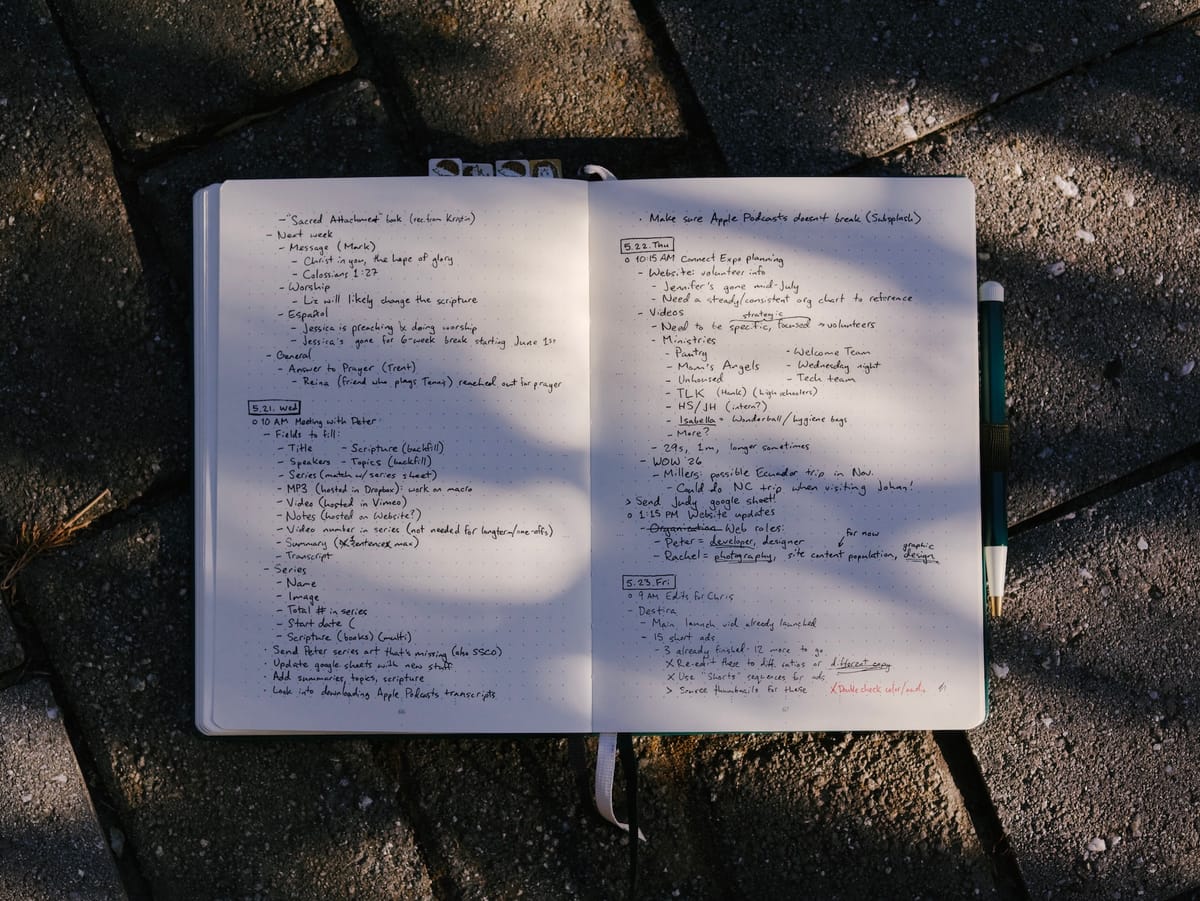How I use my Bullet Journal
Free your brain. Hack your time. Reach enlightenment I guess.

I've been recently enjoying using a paper and pen for taking notes and journaling. I've adopted the Bullet Journal method, not because it's perfect, but because it's extremely adaptable.
The BuJo brand is a bit off-putting to me, like most productivity brands. They talk a lot about freeing your brain or hacking your time or things like that, selling courses for hundreds of dollars promising some kind of enlightenment. I just want a nice way to stay organized, not a cult!
Weird branding aside, it is actually a nice framework to begin with. It’s essentially:
- Start the day by writing the date and day of the week. I use a format like “7.23.Wed”.
- Use dashes (-) for notes, thoughts, ideas, et cetera.
- Use dots (•) for tasks, and cross them off (X) when complete. Draw a line (—) through them if cancelled. Draw an arrow through them (>) if migrated elsewhere; either to a different day or a different platform, such as a task tracking app.
- Use circles (O) for events that happened, like “O 9AM Meeting”.
There’s a bit more beyond that – things like keeping a rigorous Index at the start of your journal, creating monthly spreads (for trackers, tasks, events, birthdays, etc.), and migrating incomplete items forward to the next month or year as needed. But the point of it – and the whole appeal of this kind of framework – is that you can take or leave any of it. Tweak it how you want. Add colors or different symbols. Whatever! Because, at the end of the day, it’s still just paper.
If you’ve ever used a task tracking app and thought, Man, I wish this app had metadata entry for books that I want to read so I can use it as a tracker, well, guess what? You can add that into your journal! It’s stupid simple, and honestly quite freeing to escape software that is opinionated and designed for one thing, and rediscover the original anything-tool: the pen.
Some people use their journal for everything. It's their source of truth, their one and only. I’m a little more loosey-goosey. For me, my journal is the inbox for my thoughts. If I’m in a meeting and I want to remember something, it goes in the journal. If I'm starting my week and jotting down tasks, they’ll start in the journal. If I want to have some meditative time and write bad poems, they’ll regrettably go in the journal too.
Then I’ll take tasks and copy them over to Todoist[1], thoughtfully planning out when I want to complete them. I loosely follow a GTD methodology for tasks, so the Bullet Journal essentially acts as my inbox. I dump everything there, usually at the start of my day, then either knock out the easy stuff or move things to the software I use.
Similarly, thoughts I jot down might later become notes in Apple Notes, or documentation for work, or maybe even a blog! The journal is a quick dump for what I’m thinking right now, without getting distracted by where it should go or what format it needs to be in.
It's also been fun to get back into stationery. I've always loved a good pen and neat sticky notes, but since I'm not in school anymore there's been limited use for them in my life. Bullet Journaling has really brought back the tactile joy of all that for me.
I’ve been flip-flopping between Todoist and Things 3. I like a lot about both apps. I’ve also tried Reminders, but it has some annoying limitations. At the moment, Todoist feels like the best blend of easy entry and solid organization, especially since I can link it with other tools my team uses. Things, on the other hand, is an exceptionally beautiful app. The interaction of checking off an item in Things is probably the most delightful software interaction I've ever experienced. And the fact that it approaches tasks from a GTD perspective (focusing on when you want to do a task, not just when it's due) is a framework I wish more task tracking apps leaned into. ↩︎